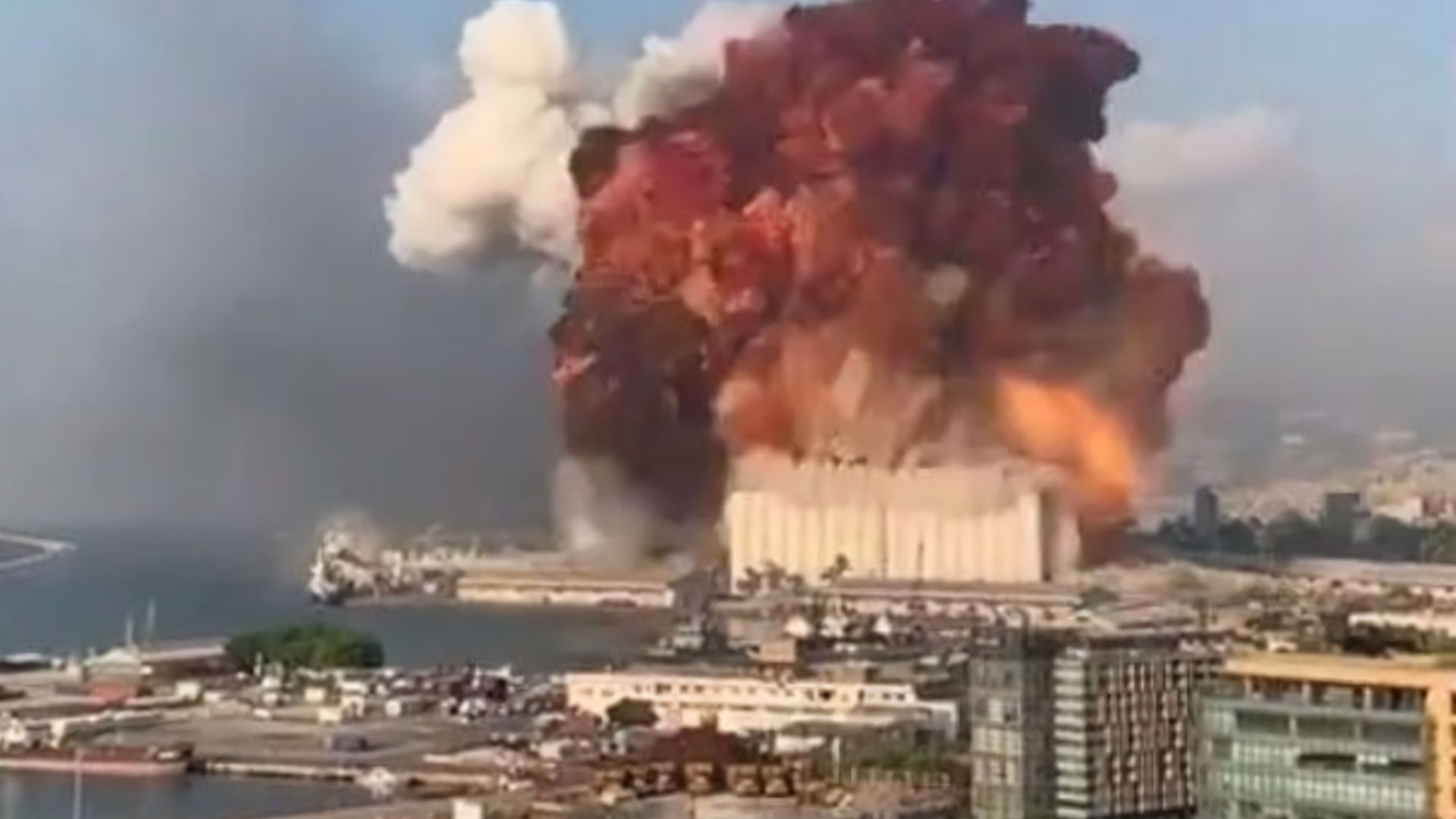The 2020 Beirut Explosion
On 4 August 2020, an ordinary summer afternoon in Beirut turned into a scene of devastation. At 6:08 PM local time, the Lebanese capital was rocked by one of the largest non-nuclear explosions in modern history. The blast tore through buildings, flipped cars, shattered glass for miles, and left a city already struggling with political instability and economic collapse reeling in grief and disbelief.
The explosion was so powerful that it registered as a 3.3 magnitude earthquake. A shockwave raced through the city, demolishing neighbourhoods and flattening parts of the port. More than 200 people were killed, over 6,000 were injured, and some 300,000 were displaced from their homes. For a city that had weathered civil war, assassinations, and foreign occupations, the blast felt like the breaking point.
The Source of the Catastrophe
At the heart of the disaster was a stockpile of ammonium nitrate, a chemical compound used primarily in fertiliser and explosives. In 2013, a Moldovan-flagged ship, the MV Rhosus, had docked in Beirut due to technical issues. It was carrying over 2,700 tonnes of ammonium nitrate, which was subsequently offloaded and stored in Warehouse 12 at the port after the ship was deemed unseaworthy.
What followed was a catalogue of negligence. For seven years, the explosive material sat in the warehouse, poorly secured and dangerously volatile. Numerous warnings were sent to Lebanese officials, including customs, judiciary, and port authorities, flagging the extreme danger posed by the stored chemicals. Letters were written. Reports were filed. But nothing was done.
On the day of the explosion, a fire broke out in the warehouse, likely triggered by welding work nearby and led to an explosion which was probably caused by a stash of fireworks being stored alongside the ammonium nitrate. Approximately 33 seconds later, the flames reached the ammonium nitrate, which then ignited in a catastrophic second blast. The result was a towering mushroom cloud, a pressure wave that swept across the city, and a crater 140 metres wide at the port’s edge. The explosion was felt as far away as Northern Israel and Cyprus.
Immediate Aftermath
Videos of the explosion circulated across the globe within hours. Mobile phone footage captured the rising smoke, the initial explosion, and then the enormous blast that sent a dome-shaped shockwave crashing into the city. People screamed as windows shattered. Drones filmed the port, now a gaping hole surrounded by twisted metal and ruin.
Hospitals, already stretched thin due to the COVID-19 pandemic, were overwhelmed. Some were damaged in the blast and had to treat patients in car parks and courtyards. The Red Cross issued urgent calls for blood donations. Glass and rubble covered streets for miles, and rescue workers struggled to reach survivors trapped beneath the debris.
Amid the chaos, Lebanon’s collective trauma deepened. Families searched for loved ones. Entire buildings were destroyed. The famous Sursock Palace, a symbol of the city’s cultural heritage, was severely damaged. Schools, museums, businesses, and homes were reduced to ruins. The psychological scars would last far longer than the dust and debris.
A Nation’s Fury
Public anger erupted almost immediately. The explosion was not seen as an accident, but as the result of criminal negligence. For years, Lebanese citizens had endured economic collapse, hyperinflation, unemployment, political paralysis, and systemic corruption. The blast became a symbol of everything that was broken in Lebanese governance.
Within days, protests flared across Beirut. Demonstrators occupied government buildings and clashed with security forces. Some carried mock nooses. Others waved black flags in mourning. Many demanded resignations, criminal accountability, and sweeping reform. The frustration was raw and justified — not only had the government failed to act on repeated warnings, but many in power had been aware of the ammonium nitrate all along.
On 10 August 2020, Prime Minister Hassan Diab announced the resignation of his cabinet. He blamed “chronic corruption” for the disaster, a phrase that resonated with a public who had heard it all before. But his departure did little to ease tensions. Investigations into the blast began, but they were quickly mired in political interference, delays, and denials.
Global Reaction and Humanitarian Aid
The international response was swift. Countries around the world offered assistance, including search and rescue teams, medical supplies, and financial aid. France’s President Emmanuel Macron visited Beirut just two days after the explosion, walking through devastated neighbourhoods and calling for a transparent international investigation.
Non-governmental organisations and civil society groups led much of the relief effort. With faith in government institutions shattered, many Lebanese citizens relied on volunteers and independent organisations for food, shelter, and medical help. A wave of grassroots mobilisation took place, from local kitchen collectives feeding families to architects offering free repairs to damaged homes.
While pledges of aid came quickly, many donors were wary of channelling funds through the Lebanese state, fearing corruption and misuse. Calls intensified for reforms and accountability before long-term rebuilding funds would be released.
A Wounded Capital
Beirut’s history is marked by resilience. The city has risen from the ashes more than once — through civil war, assassinations, and bombings. Yet the 2020 explosion felt different. A foreign power, a militia, or a terrorist group didn’t cause it. It was a disaster born in Lebanon, a product of complacency, neglect, and political decay.
In the months that followed, the city began to rebuild. But the process was uneven and fraught with obstacles. The Lebanese pound continued to plummet. Power cuts, fuel shortages, and food insecurity deepened. Many young people began to view emigration as the only viable option for their future. Even those who stayed often did so with a heavy heart.
Cultural landmarks were slowly restored, but the human toll remained sharp. Memorials were held for the victims. Artists painted murals on crumbling walls. Families demanded answers that never came. And in the background, the same politicians remained in power, reshuffling roles but resisting reform.
Memory, Grief, and a Search for Justice
As of summer 2025, no high-ranking official has been held accountable for the explosion. Multiple judges assigned to the investigation have been removed or obstructed. Political factions have used legal manoeuvres to stall proceedings. International human rights groups, including Amnesty International and Human Rights Watch, have condemned the Lebanese authorities for what they describe as a deliberate obstruction of justice.
Survivors and victims’ families continue to protest. They hold portraits of the dead, march through the streets, and light candles outside the port. They want justice, not just compensation. They want those responsible — whether through action or inaction — to be held accountable for what happened. Their fight has become symbolic of a larger struggle in Lebanon, one not just for accountability, but for dignity.
Broken Glass, Broken Trust
The Beirut explosion was not just a physical catastrophe. It shattered trust, faith, and the already fragile relationship between the people and their leaders. It exposed a system incapable of safeguarding its citizens, even from the danger it had itself created.
In a matter of seconds, lives were destroyed, history was erased, and the future of an entire generation was cast into uncertainty. But amid the rubble, Beirut’s citizens did what they have always done. They picked up brooms, bandaged wounds, cooked for their neighbours, and refused to let the city fall entirely.
It was not government trucks that arrived first. It was ordinary people. Volunteers. Teachers. Medics. Artists. Students. The same people who had protested corruption, endured hardship, and demanded reform. In their actions, a quiet form of defiance echoed across the city. Beirut is still rebuilding. Its people are still waiting. The explosion may have been one moment in time, but its consequences stretch far beyond that August day. For many, the true reckoning has yet to arrive.
The 2020 Beirut Explosion FAQ
The explosion was caused by the ignition of 2,750 tonnes of improperly stored ammonium nitrate in a warehouse at the Port of Beirut.
Over 200 people were killed, more than 6,000 were injured, and around 300,000 were left homeless in the wake of the explosion.
As of July 2025, no high-ranking official has been successfully prosecuted, and the investigation has faced political obstruction and delays.
Countries and NGOs around the world sent aid, medical supplies, and rescue teams. Many called for an independent investigation into the disaster.






